Choosing the right canvas for acrylic pouring is essential and can be a fun adventure! Start with a cotton canvas for affordability and ease, but remember that linen canvases, with their snug weave and lasting quality, truly shine if you’re aiming for premium masterpieces. Pre-primed canvases save time, making your colors pop without extra prep, while canvas panels provide a sturdy, wallet-friendly option. Don’t forget to check the canvas weight; thicker ones are stable and resist warping. Whether you’re exploring wild, bold designs or delicate details, the canvas type you pick sets the stage for your art magic! Curious about more tips? Keep going, there’s so much more to discover!
Key Takeaways
- Choose cotton canvases for affordability and versatility, ideal for beginners.
- Opt for linen canvases for superior texture, durability, and less gesso requirement.
- Ensure canvases are well-primed to enhance color vibrancy and prevent paint absorption.
- Select canvas size based on your design needs; larger canvases require more paint and drying time.
Understanding Canvas Basics
Understanding the fundamental aspects of canvases is essential for mastering the art of acrylic pouring. The canvas, with its rich history, has been a preferred surface for artists for centuries. Initially made from hemp, its evolution brought forward materials like cotton and linen, each offering unique benefits to the artistic techniques employed by painters.
Cotton canvases are often chosen by beginners due to their affordability, while linen canvases are revered by professionals for their superior texture and durability. The texture of the canvas plays a vital role in how the paint interacts with the surface.
Smoother canvases are ideal for detailed work, allowing for precise brushstrokes and intricate designs. In contrast, rougher textures are more suited for broader strokes and bold applications, providing a dynamic base for expressive artistic techniques.
Canvases come in various forms, such as pre-stretched, canvas panels, and rolls. Pre-stretched canvases save artists preparation time, making them ready to use immediately. Canvas panels and rolls offer customization and affordability, catering to different artistic needs.
Proper priming with gesso enhances paint adherence and vibrancy, ensuring the acrylics maintain their brilliance and longevity on the canvas.
Importance of Canvas Selection
Selecting the right canvas for acrylic pouring is essential for achieving the best results, as the type of fabric, surface preparation, and size all influence the outcome.
Whether you choose cotton for its accessibility or linen for its durability, understanding these factors will help you make an informed decision.
Additionally, ensuring the canvas is properly primed can enhance color vibrancy and prevent paint absorption, ultimately leading to a more vibrant and lasting piece of art.
Fabric Type Considerations
When choosing a canvas for acrylic pouring, it is crucial to contemplate the type of fabric, as this can greatly affect the durability, texture, and overall outcome of the artwork.
When comparing canvas fabric options, the durability comparison between cotton and linen is particularly remarkable. Cotton canvases, often chosen by beginners due to their affordability, provide a good starting point. They are versatile and easily accessible, making them a popular choice.
However, linen canvases offer superior quality and longevity. Linen’s tighter weave and higher thread count create a denser material, which can better withstand the weight of poured paint without warping or sagging. This durability guarantees that your artwork remains intact over time, maintaining its vibrant appearance.
The texture of the canvas fabric is another critical factor. Smoother surfaces facilitate better paint flow and allow for more intricate and vibrant patterns. Consequently, higher-quality canvases with a finer texture can appreciably enhance the visual appeal of your final piece.
While cotton is budget-friendly and practical, investing in linen can boost the quality and longevity of your acrylic pour paintings, making it a worthwhile consideration for serious artists.
Surface Preparation Essentials
Properly preparing the canvas surface is fundamental for achieving the best results in acrylic pouring, as it directly influences paint adhesion, flow, and the overall durability of the artwork.
One of the first steps in surface preparation is thorough surface cleaning. A clean, dust-free canvas is essential to avoid imperfections like bubbles or unwanted textures in the final piece. Even a tiny speck of dust can disrupt the smooth flow of acrylic paint, so make certain to wipe the canvas with a damp cloth and let it dry completely before starting.
Next up are priming techniques. Priming your canvas guarantees that the paint adheres well and prevents it from being absorbed unevenly. Most canvases come pre-primed, but applying an additional layer of gesso can considerably improve the paint’s performance. This extra layer helps create a smooth, even surface, which is fundamental for fluid movements and the enhanced visual effects that make acrylic pouring so enticing.
Confirming that your workspace and canvas are level can’t be overlooked either. An uneven surface can cause the paint to pool or dry unevenly, which can ruin the intricate patterns you’ve worked so hard to create.
Size and Weight Factors
In acrylic pouring, the dimensions and heft of the canvas play a significant role in shaping the final outcome and overall experience of the artist.
Choosing the right canvas dimensions can greatly impact your artwork. Larger canvases offer a grandiose space for expansive designs, while smaller ones are perfect for practice and experimentation.
Additionally, understanding weight variations is essential. Heavier canvases, usually 10 oz or more, provide robust support for thick layers of paint, reducing the risk of warping during the drying process. On the other hand, lighter canvases are easier to transport, making them ideal for artists who wish to paint on location.
- Medium-sized canvases (e.g., 16×20 inches): Ideal for beginners, offering a balance between manageable space and detailed design.
- Heavyweight canvases (10 oz or more): Essential for thick layers of acrylic paint, ensuring stability and reducing warping.
- Lightweight canvases: Great for portability, allowing artists to work in various locations without hassle.
Types of Canvas Materials
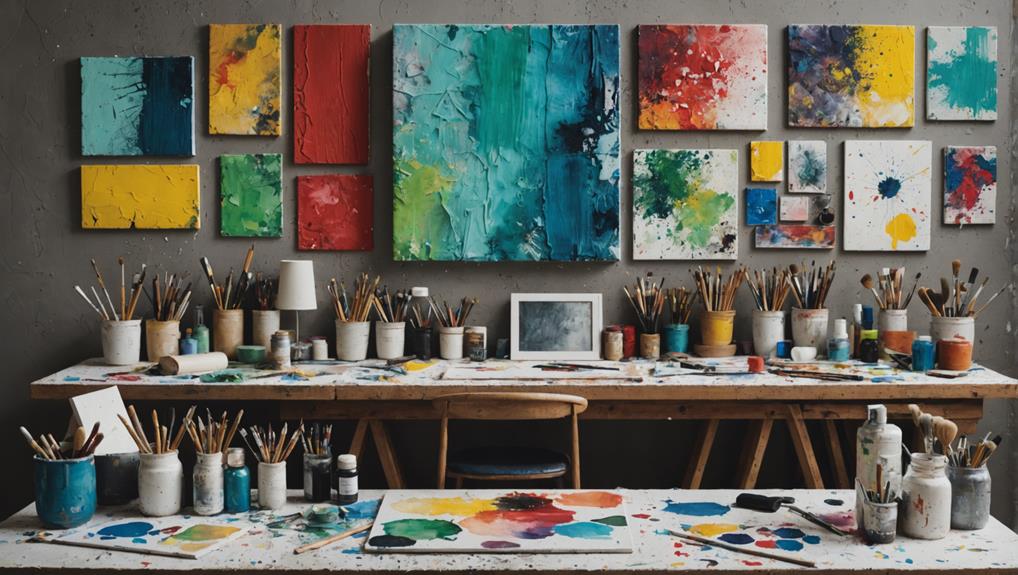
When it comes to choosing canvas materials for acrylic pouring, understanding the differences between linen and cotton is essential.
Linen canvas offers exceptional durability and a smoother surface, ideal for professional artists, while cotton canvas provides an affordable and versatile option, perfect for beginners.
Additionally, deciding between primed and unprimed canvases can greatly impact your painting’s outcome, as primed canvases are ready to use immediately, saving time and effort.
Linen Vs. Cotton
Choosing between linen and cotton canvases is an essential decision that can greatly impact the quality and longevity of your acrylic pouring artwork. Each material offers distinct advantages that cater to different needs and preferences.
Linen Advantages:
- Durability: Linen canvases are renowned for their exceptional durability, making them a long-lasting option for professional artists.
- Superior Surface Quality: The finer texture of linen provides better paint adhesion and a smoother finish, enhancing the overall appearance of your artwork.
- Higher Thread Count: Linen’s higher thread count contributes to its strength, ensuring that the canvas can withstand the rigors of acrylic pouring without warping or sagging.
Cotton Affordability:
- Affordability: Cotton canvases are more affordable and accessible, making them an excellent choice for beginners and casual painters exploring acrylic pouring.
- Versatility: Cotton’s pronounced texture can add a unique character to your artwork, although it may affect the final appearance.
- Variable Quality: Cotton canvases vary in quality, depending on the weight and type of cotton used, offering options for different budgets and preferences.
Primed Vs. Unprimed
Understanding the differences between primed and unprimed canvases is another key consideration that directly influences the success of your acrylic pouring projects.
Primed canvases offer significant benefits, such as being coated with gesso, which prevents excessive paint absorption and enhances paint adhesion. This makes them ideal for acrylic pouring techniques, as they help maintain vibrant color integrity and prevent issues like cracking or crazing during the drying process, especially with heavy pours.
On the other hand, unprimed canvases present unique challenges. While they offer a distinctive textured finish that some artists appreciate, they can lead to uneven absorption of paint. This unevenness often requires additional preparation and multiple layers of paint to achieve the desired effects, which can be time-consuming and may necessitate extra drying time.
Additionally, most commercial canvases, particularly those labeled for acrylic use, come pre-primed with acid-free gesso, ensuring maximum performance for fluid painting methods.
For artists experimenting with unprimed canvases, the process might be more labor-intensive, but it can yield unique results. However, the primed benefits generally make primed canvases a more convenient and reliable choice for achieving consistent, high-quality outcomes in acrylic pouring.
Stretched Canvas Options
Stretched canvases, mounted on sturdy wooden frames, offer a reliable and versatile surface for artists engaging in acrylic pouring techniques. The process of canvas stretching guarantees a taut and even surface, which is vital for the fluid dynamics of acrylic pouring. Proper canvas framing provides the necessary support, preventing warping and maintaining the integrity of the artwork during and after the application of paint.
Stretched canvases come in various sizes, catering to both small-scale projects and expansive masterpieces. Most options are pre-primed with gesso, enhancing paint adhesion and minimizing absorption, which is fundamental for achieving the desired flow and finish in acrylic pouring. The weight and thickness of these canvases can vary greatly; heavier canvases offer increased durability, ideal for the thicker layers of paint commonly used in pouring techniques.
To summarize, the benefits of using stretched canvases for acrylic pouring include:
- Pre-primed surfaces: Improved paint adhesion and reduced absorption.
- Varied sizes: Options to suit different project scales.
- Durability: Heavier canvases support thicker paint layers.
Choosing the right stretched canvas guarantees a stable, high-quality foundation for your acrylic pouring artwork.
Canvas Panels Explained
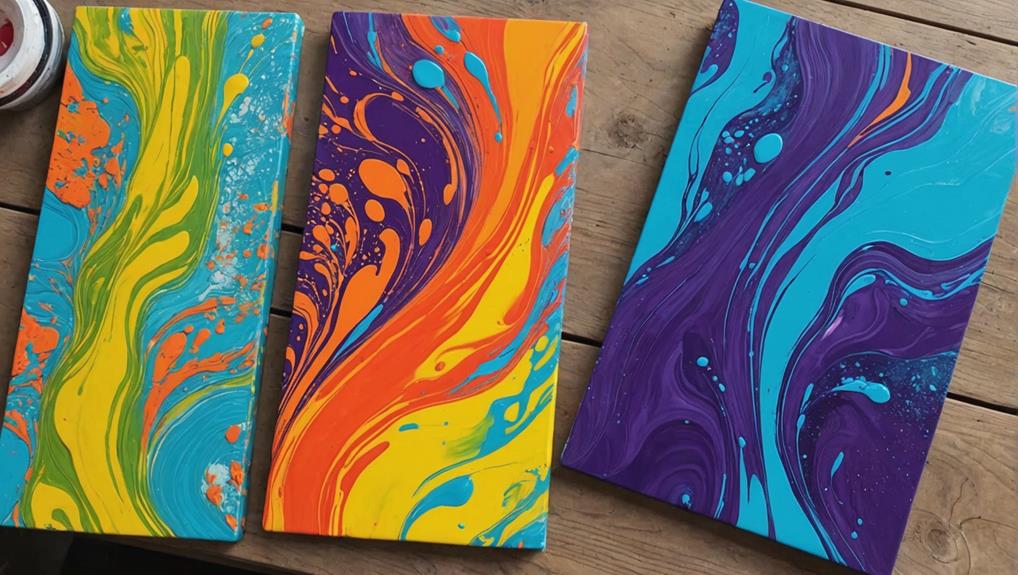
While stretched canvases offer a traditional and durable option for acrylic pouring, canvas panels provide a cost-effective and sturdy alternative for artists exploring this technique. Canvas panels are fundamentally a rigid board surface covered with canvas, making them less prone to warping. This stability is one of the key canvas panel benefits, especially for acrylic pouring, where the paint can be quite heavy.
They are typically more affordable than stretched canvases, which is great news if you’re a beginner or if you like to practice different pouring techniques without breaking the bank. Another advantage is their availability in various sizes, and because they are lightweight, they’re super easy to store and transport. Most canvas panels come pre-primed with gesso, so you can dive right into your painting without any prep work. This guarantees better paint adhesion and vibrant colors.
However, there are some canvas panel drawbacks to reflect on. They are best suited for smaller artworks or studies. The rigid surface might not hold up well under the heavy paint application used in larger acrylic pour paintings.
Using Canvas Pads
Canvas pads offer a flexible and portable solution for artists engaging in acrylic pouring, making them an excellent choice for both practice and experimentation. These spiral-bound sheets are typically made from cotton or a cotton-polyester blend, providing a lightweight option that’s easy to transport. One of the significant canvas pad advantages is that they come pre-primed, so you can dive right into your acrylic pouring techniques without any extra preparation.
Canvas pads are available in a variety of sizes, from compact 5×7 inches to more expansive 18×24 inches, offering versatility for different project scales. The texture can vary as well, which is perfect for artists who enjoy experimenting with different effects:
- Smooth surfaces are ideal for detailed work
- Rougher textures complement broader strokes and abstract styles
- Economical choice for beginners wanting to practice without high costs
These features make canvas pads particularly appealing for those who are new to acrylic pouring or looking to try out new techniques without committing to more expensive stretched canvases.
Whether you’re working on small studies or larger projects, canvas pads provide a practical and versatile canvas option.
Benefits of Canvas Rolls
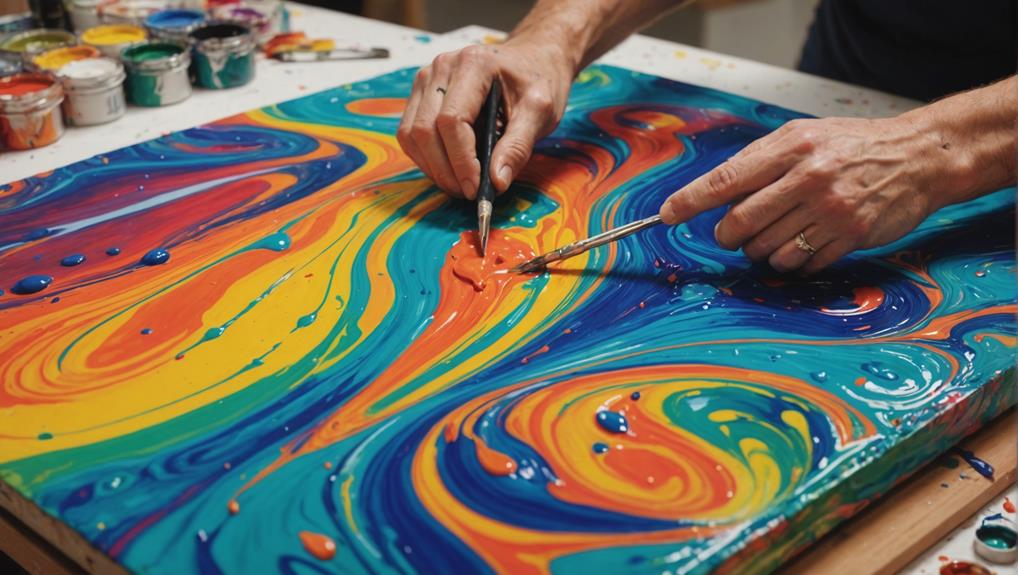
Opting for canvas rolls offers artists unparalleled flexibility to customize their canvas dimensions precisely to their creative needs. This adaptability allows for the creation of both small and large artworks, liberating artists from the constraints of pre-stretched options. Additionally, canvas rolls are typically more cost-effective, especially for those who need larger surfaces or multiple pieces, making them a budget-friendly choice.
Canvas rolls, often made from high-quality cotton or linen, guarantee durability and provide a suitable texture for acrylic pouring applications. This durability means that artists can stretch their own canvases, giving them greater control over tension and surface quality, which is a significant advantage over pre-stretched canvases that can warp over time.
Moreover, canvas rolls open up a world of alternative applications and creative techniques. Artists can experiment with different textures and finishes by priming and preparing the surface according to their specific preferences. This level of customization means that the canvas can be tailored to suit a variety of artistic styles and methods, enhancing the overall creative process.
Whether for traditional paintings or innovative acrylic pouring, canvas rolls offer a versatile and economical solution for artists at any level.
Primed Vs. Unprimed Canvas
Choosing between primed and unprimed canvas is a critical decision that can greatly impact the outcome of an acrylic pouring project.
Primed canvases, treated with gesso, offer significant advantages by preventing paint absorption and ensuring better adhesion. This results in more vibrant colors and smoother applications, which are essential for achieving stunning acrylic pours.
On the other hand, unprimed canvases, while offering a unique, textured finish, come with their own set of drawbacks. Uneven paint absorption can lead to inconsistent results and may require additional layers of paint to achieve the desired look.
Most commercially available canvases come pre-primed, providing a convenient option that is ready for immediate use. However, using unprimed canvas can be a cost-effective choice for experimental work, though it may necessitate applying a layer of gesso for ideal results.
Overall, primed canvases are generally recommended for acrylic pouring due to their ability to enhance the paint’s flow and minimize the risk of cracking during the drying process.
- Primed advantages: Better adhesion, vibrant colors, smooth application, ready-to-use
- Unprimed drawbacks: Uneven absorption, additional layers needed, experimental use, requires gesso
- Primed canvas: Enhances paint flow, reduces cracking
Canvas Weight and Thickness
When it comes to acrylic pouring, the weight and thickness of your canvas play an essential role in the durability and overall quality of your artwork.
Heavier canvases, measured in grams per square meter (GSM), offer stronger support for thick layers of paint, while thicker canvases, usually 3/4 inch or more, prevent bending under the weight of multiple layers.
Selecting the right canvas means finding a balance that suits your technique and budget, ensuring your masterpiece stands the test of time.
Importance of Canvas Weight
The weight and thickness of a canvas play vital roles in ensuring the durability and stability of acrylic pour paintings. Understanding the canvas weight benefits and the heavy canvas advantages can greatly enhance the quality of your artwork.
A heavier canvas, typically measured in ounces per square yard, offers several distinct advantages:
- Enhanced Durability: Heavier canvases (10 oz or more) provide robust support, vital for handling the thick layers of acrylic paint used in pouring techniques.
- Reduced Warping: Thicker canvases (around 1.5 inches deep) are less prone to warping, ensuring your artwork maintains its shape over time.
- Better Absorption: A heavier canvas allows for better absorption of paint, minimizing the risk of sagging or bowing, which is particularly important when using substantial amounts of pouring medium.
Choosing the right canvas weight is not just about durability but also about ensuring your artwork looks its best. A heavier canvas offers stability and support, making it a key factor in the success of your acrylic pouring projects.
Thickness Impact on Durability
A thicker canvas considerably enhances the durability of acrylic pour paintings by providing a stable and robust surface that resists warping and sagging.
When it comes to canvas longevity, the thickness of the canvas plays a vital role. Heavier canvases, usually measured at 12 ounces per square yard or more, are particularly beneficial for acrylic pouring because they can support the weight of thicker paint layers without bending or stretching.
Using a thicker canvas, often greater than 3/4 inch, guarantees a stable painting surface. This added sturdiness is essential, especially when employing more aggressive pouring techniques, which can exert significant pressure and weight on the canvas. This stability not only prevents warping but also extends the lifespan of the artwork.
Additionally, thicker canvases typically come pre-stretched and primed, providing a ready-to-use, sturdy foundation for your pouring projects. This convenience saves time and effort, allowing artists to focus on their creative process.
Furthermore, the choice of a thicker canvas can enhance the dimensional effect of the paint layers, adding pronounced visual depth to the finished piece. By choosing a thicker canvas, artists can guarantee that their acrylic pour paintings remain vibrant and durable for years to come.
Selecting Optimal Canvas Type
Understanding the ideal canvas type for acrylic pouring involves carefully considering both canvas weight and thickness to guarantee the best possible results. The right combination can greatly impact the stability and quality of your artwork, particularly when employing various pouring techniques.
Canvas weight is measured in ounces per square yard, and it’s essential to match the weight to your project needs:
- Heavier canvases (10-12 oz) offer sturdier support for thick acrylic layers.
- Lighter canvases (5-7 oz) are better suited for lighter applications and smaller works.
- Properly primed canvases with a weight of at least 10 oz help in preventing absorption and assuring paint flow consistency.
Similarly, canvas thickness plays a vital role in maintaining tension and stability during pouring techniques. Thicker canvases, around 1.5 inches, are preferable for heavy pours as they reduce the risk of warping.
Conversely, thinner canvases can effectively support lighter techniques. When selecting your canvas, always consider the method you’ll use to make sure your masterpiece remains intact and vibrant.
Texture Considerations
Selecting the appropriate texture for a canvas is essential, as it greatly impacts the behavior and visual outcome of acrylic pours. When aiming for textured effects, the choice of canvas texture cannot be underestimated.
A smoother canvas allows for better pour control and more refined paint interaction, making it ideal for intricate designs and detailed work. Conversely, rougher textures can enhance visual interest by creating unique patterns and trapping air bubbles, which can form intriguing cells during the pour.
Durability considerations also come into play, especially with heavy pours. A sturdy, textured surface can prevent issues like warping or bowing, ensuring your artwork remains intact over time. The texture of the canvas can greatly influence your final piece, either complementing or detracting from your intended effects.
Ultimately, artists should thoughtfully select the canvas texture based on their creative goals. If you desire clean lines and precise control, a smoother canvas is the way to go. However, if you’re looking to explore dynamic, unpredictable patterns, opting for a rougher texture might be more suitable.
Linen Vs. Cotton Canvas
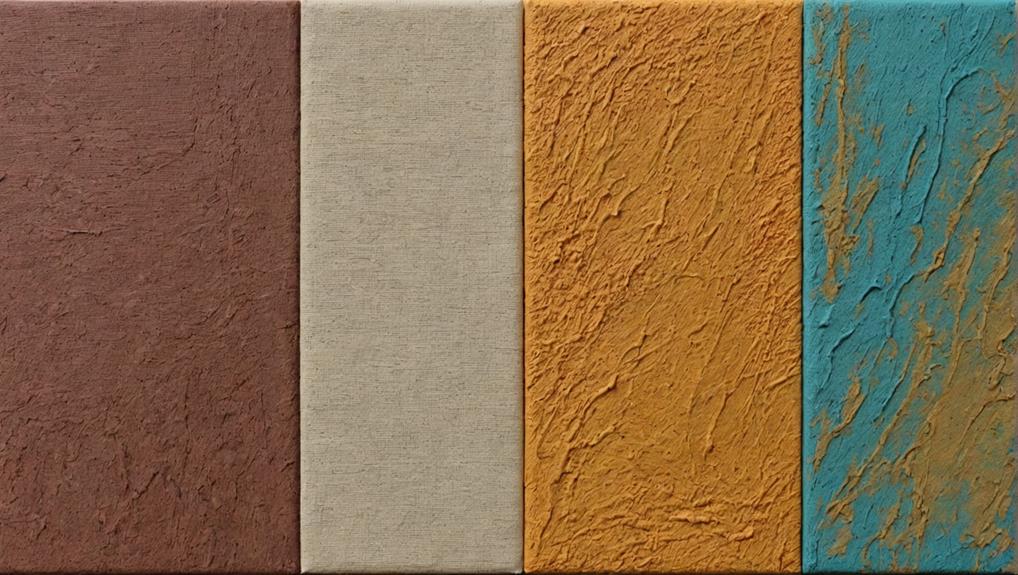
When deciding between linen and cotton canvas for acrylic pouring, it’s essential to evaluate the benefits of each material regarding quality, durability, and cost.
Linen canvas, known for its higher thread count and density, offers superior surface quality and durability, making it a preferred choice for professional artists who seek long-lasting works.
On the other hand, cotton canvas provides a cost-effective alternative that is perfect for beginners and hobbyists due to its good quality and versatility.
Here are some key points to evaluate:
- Linen benefits: Superior surface quality and durability, higher thread count and density, preferred by professional artists.
- Cotton advantages: Cost-effective, versatile, and good quality, ideal for beginners and hobbyists.
- Durability: Linen can hold paint better and withstand wear over time, while cotton is suitable for practice and experimentation.
When selecting between linen and cotton, assess your intended use and budget.
While linen is great for creating high-quality, long-lasting pieces, cotton is excellent for practice and experimentation without breaking the bank.
Preparing Your Canvas
To achieve ideal results in acrylic pouring, it is essential to properly prepare your canvas by priming it with gesso. This step is significant as it prevents paint absorption and enhances adherence, creating a suitable surface for acrylic pouring techniques. A smooth canvas surface is key; rough textures can disrupt the flow and distribution of paint, leading to less desirable outcomes.
Selecting a stretched canvas that is properly tensioned is another important aspect of preparation. This helps in avoiding warping during the pouring process, which can cause uneven results. Additionally, maintaining a level workspace is a fundamental canvas maintenance tip that guarantees even paint distribution and prevents pooling in one area.
For smaller projects, consider using a canvas panel. These are lightweight and provide a firm surface, maintaining the integrity of the pour. Here’s a quick summary of these significant points:
| Preparation Step | Benefit |
|---|---|
| Priming with Gesso | Prevents paint absorption |
| Using Smooth Canvas | Guarantees even paint flow and distribution |
| Properly Tensioned Canvas | Avoids warping and uneven results |
| Level Workspace | Guarantees even paint distribution |
| Using Canvas Panels | Ideal for smaller, lightweight projects |
Best Sizes for Acrylic Pouring
After properly preparing your canvas, choosing the right size for acrylic pouring is essential for achieving your desired artistic outcome. The dimensions of your canvas play a vital role in the overall aesthetic and execution of your artwork, so it’s important to select a size that aligns with your vision and skill level.
For those new to acrylic pouring, an 8×10 inch canvas is a perfect starting point. This manageable size offers enough space for experimentation without being overwhelming. As you gain confidence, you might want to try medium-sized canvases, such as 16×20 inches. These provide ample room for more intricate designs and layering techniques.
When considering larger canvases, like 24×36 inches or even bigger, be aware that they can create dramatic, eye-catching pieces but will require more paint and careful handling to prevent bowing. Additionally, the aspect ratio of your canvas can influence your composition; for instance, a square canvas (such as 12×12 inches) opens up different design possibilities compared to a rectangular one.
Keep in mind:
- Workspace and drying conditions are essential.
- Larger canvases demand more paint and stability.
- Square versus rectangular canvases offer varied design opportunities.
Choosing the right canvas size can greatly impact your acrylic pouring experience and results.
Customizing Canvas Surfaces
Enhancing your canvas surface for acrylic pouring can greatly impact the final outcome of your artwork, offering improved paint adhesion and more vibrant colors.
To get started, applying a layer of gesso is crucial. Gesso acts like a primer, reducing canvas absorption and allowing for smoother paint application. There are different gesso types you can use: fine gesso for smooth, detailed results and coarse gesso for more dramatic, expressive finishes. This texture experimentation can add a unique touch to your art.
Before you apply gesso, lightly sanding the canvas can create an even smoother surface, making the paint flow better and reducing the risk of uneven drying. Additionally, using canvas panels or boards instead of stretched canvases can be beneficial. They provide a sturdier surface, which is less prone to warping, especially under heavy pours of paint.
Once your artwork is dry, consider adding a layer of clear acrylic medium or varnish. This not only adds a glossy effect but also protects your masterpiece from dust and UV exposure.
Budget-Friendly Canvas Choices
When it comes to budget-friendly canvas choices for acrylic pouring, there are several options that won’t break the bank.
Canvas panels are lightweight and affordable, perfect for beginners or practice pieces.
Additionally, canvas pads and 100% cotton canvases offer economical alternatives without compromising on quality.
Buying canvas rolls can provide flexibility and savings for various project sizes.
Affordable Canvas Panels
For artists seeking a cost-effective and versatile surface for acrylic pouring, canvas panels offer an excellent solution. These panels are not only budget-friendly but also provide a sturdy option for experimenting with various pouring techniques.
Here are some key canvas panel advantages that make them ideal for budget painting techniques:
- Affordability: Canvas panels are typically priced between $1 to $5 each, making them accessible for artists of all levels, particularly beginners.
- Versatility: They come in a wide range of sizes and shapes, allowing artists to choose the perfect panel for their specific project, whether it’s a small study or a larger artwork.
- Pre-primed Surface: Many canvas panels are pre-primed, which enhances paint flow and color vibrancy, reducing the need for additional preparation and allowing for immediate use.
Cost-Effective Canvas Pads
While canvas panels offer an affordable and versatile option for acrylic pouring, another cost-effective choice worth considering is canvas pads. These pads are great for anyone looking to practice and experiment without breaking the bank. One of the main canvas pad advantages is their lightweight, portable format, which makes them easy to carry around and perfect for on-the-go creativity.
Canvas pads come in various sizes, from 9×12 inches to larger dimensions, giving you the flexibility to choose what best fits your project. They come pre-primed, so the surface is ready for your acrylic pouring techniques, ensuring good paint adhesion and preventing the canvas from absorbing too much paint. This allows you to focus on your art rather than worrying about preparation.
Besides being budget-friendly, canvas pads are especially accessible for beginners. You get multiple sheets in one pad, so you can explore different techniques without a significant financial investment. Many canvas pads also feature a spiral binding, making it easy to flip through and store your work.
This convenience is perfect for quick studies and keeping your creative ideas organized. So, if you’re looking for a cost-effective and practical option, canvas pads are definitely worth a try!
Economical Stretched Canvas
Economical stretched canvases frequently provide an excellent balance of affordability and quality, making them ideal for both beginners and budget-conscious artists. These canvases are generally made from cotton, guaranteeing a durable yet cost-effective option for acrylic pouring.
Here are some key points to take into account:
- Pre-Stretched and Pre-Primed: Many budget options come pre-stretched and pre-primed with gesso, so you can dive right into your painting without any prep work.
- Versatile Sizes: A common size for these canvases is 16×20 inches, giving you enough space to experiment with various pouring techniques.
- Medium Weight: Typically around 8-10 oz, these canvases can handle moderate layers of paint without warping, which is essential for acrylic pouring.
For beginners, these economical stretched canvases are a fantastic way to get started without breaking the bank. The pre-primed surface saves time and effort, allowing you to focus on perfecting your pouring techniques.
Plus, the medium weight guarantees that your artwork remains intact, even with the thick, flowing layers characteristic of acrylic pouring. So, if you’re looking for budget options, these canvases provide the perfect blend of quality and affordability.
Frequently Asked Questions
How to Choose a Canvas for Acrylic Painting?
Choosing a canvas for acrylic painting involves selecting between canvas types like cotton or linen based on experience level. Additionally, consider surface texture, with smooth textures favoring detailed work and rough textures suitable for broader strokes.
How Can You Tell if a Canvas Is Good Quality?
Evaluating canvas quality involves examining the canvas texture for a higher thread count, ensuring it is well-primed to reduce paint absorption, and verifying proper stretching. Established brands often provide reliable materials meeting professional standards.
What Is the Formula for Acrylic Pouring?
The formula for acrylic pouring involves using a paint ratio of 2 parts pouring medium to 1 part acrylic paint. Effective pouring techniques also suggest adding distilled water sparingly and incorporating silicone oil to create cells and patterns.
What Weight Canvas Is Best for Acrylic Painting?
For acrylic paint, a canvas weight of 10-12 oz is recommended as it provides adequate support for heavy paint layers, preventing warping or bowing, and ensuring the integrity of the artwork throughout the drying process.
Conclusion
Choosing the right canvas for acrylic pouring is essential for achieving ideal results.
Understanding the basics of canvas, the significance of selection, and the diversity of materials available can greatly influence the outcome of the artwork.
Exploring options such as stretched canvases and canvas panels, along with proper preparation and customization, guarantees a suitable surface for pouring.
Considering size and budget-friendly choices further enhances the process, leading to a successful and satisfying artistic experience.

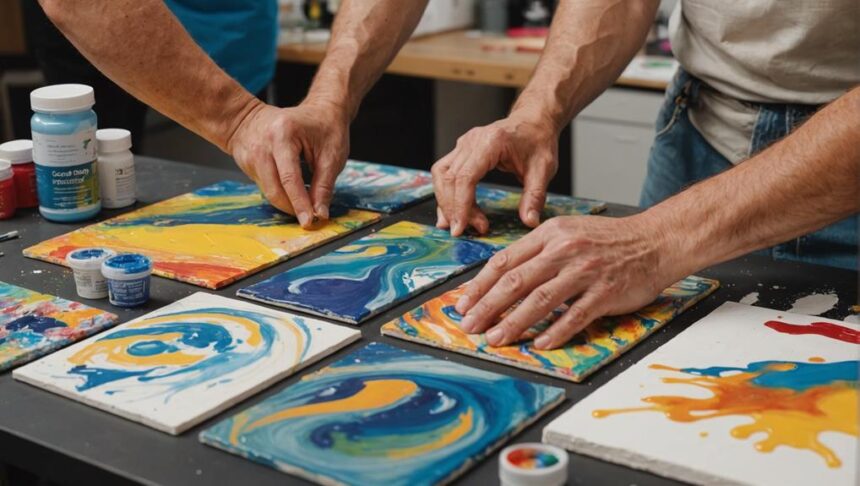
Leave a Reply